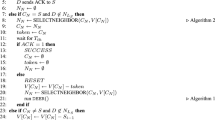Abstract
Power loss and interference coexist in wireless transmissions where random uncertainty is aggravated due to the mobility of sensor nodes. A probability interference model was proposed, based on the physical model and random fading of the received signal power, to depict the uncertainty of wireless interference. In addition, an interference-aware routing metric was designed, in which interference, routing convergence and residual energies of nodes were integrated. Furthermore, an interference-aware probabilistic routing algorithm was proposed for mobile wireless sensor networks, and its correctness and time and space complexities were proved. The NS-2 simulation experiments showed that the proposed algorithm can achieve higher packet delivery ratio than Greedy Perimeter Stateless Routing in various cases like the pause time and maximum moving speed. Simultaneously, the energy consumption of a packet and average delay were taken into consideration to better meet the needs of mobile scenarios with higher reliability.














Similar content being viewed by others
References
Rappaport, T. S. (2001). Wireless communications: Principles and practice. Upper Saddle River, NJ: Prentice Hall PTR.
Moazzez Estanjini, R., Wang, J., & Paschalidis, I. C. (2013). Scheduling mobile nodes for cooperative data transport in sensor networks. IEEE/ACM Transactions on Networking, 21(3), 974–989.
Gupta, P., & Kumar, P. R. (2000). The capacity of wireless networks. IEEE Transactions on Information Theory, 46(2), 388–404.
Teo, J. Y., Ha, Y., & Tham, C. K. (2008). Interference-minimized multipath routing with congestion control in wireless sensor network for high-rate streaming. IEEE Transactions on Mobile Computing, 7(9), 1124–1137.
Levin, L., Segal, M., & Shpungin, H. (2013). Interference-free energy efficient scheduling in wireless ad hoc networks. Ad Hoc Networks, 11(1), 201–212.
Tang, J., Xue, G., Chandler, C., & Zhang, W. (2005). Interference-aware routing in multihop wireless networks using directional antennas. In Proceedings of the 24th annual joint conference of the IEEE Computer and Communications Societies (INFOCOM 2005), pp. 751–760, Miami, FL, USA.
Li, Z., Li, D., & Liu, M. (2010). Interference and power constrained broadcast and multicast routing in wireless ad hoc networks using directional antennas. Computer Communications, 33(12), 1428–1439.
Kandah, F., Zhang, W., Wang, C., & Li, J. (2012). Diverse path routing with interference and reusability consideration in wireless mesh networks. Mobile Networks and Applications, 17(1), 100–109.
Huang, H., Hu, G., Yu, F., & Zhang, Z. (2011). Energy-aware interference-sensitive geographic routing in wireless sensor networks. IET Communications, 5(18), 2692–2702.
Shi, Y., Hou, Y. T., Liu, J., & Kompella, S. (2013). Bridging the gap between protocol and physical models for wireless networks. IEEE Transactions on Mobile Computing, 12(7), 1404–1416.
Li, H., Wu, C., Hua, Q. S., & Lau, F. C. M. (2011). Latency-minimizing data aggregation in wireless sensor networks under physical interference model. Ad Hoc Networks. doi:10.1016/j.adhoc.2011.12.004.
Lu, J., & Wang, X. (2012). Interference-aware probabilistic routing for wireless sensor networks. Tsinghua Science and Technology, 17(5), 575–585.
Ji, S., He, J., Pan, Y., & Li, Y. (2013). Continuous data aggregation and capacity in probabilistic wireless sensor networks. Journal of Parallel and Distributed Computing, 73(6), 729–745.
Chafekar, D., Anil Kumar, V. S., Marathe, M. V., Parthasarathy, S., & Srinivasan, A. (2011). Capacity of wireless networks under SINR interference constraints. Wireless Networks, 17(7), 1605–1624.
Resta, G., & Santi, P. (2012). The fundamental limits of broadcasting in dense wireless mobile networks. Wireless Networks, 18(6), 679–695.
Jain, K., Padhye, J., Padmanabhan, V. N., & Qiu, L. (2005). Impact of interference on multi-hop wireless network performance. Wireless Networks, 11(4), 471–487.
Zeng, Y., Xiong, N., Park, J. H., & Yang, L. T. (2012). An interference-aware multichannel media access control protocol for wireless sensor networks. The Journal of Supercomputing, 60(3), 437–460.
Namboothiri, P. G., & Sivalingam, K. M. (2013). Throughput analysis of multiple channel based wireless sensor networks. Wireless Networks, 19(4), 461–476.
Zhang, X., Yu, H., Liang, W., & Zheng, M. (2011). Joint routing, scheduling, and power control for multichannel wireless sensor networks with physical interference. Journal of Control Theory and Applications, 9(1), 93–105.
Kan, B. Q., & Fan, J. H. (2012). Interference activity aware multi-path routing protocol. EURASIP Journal on Wireless Communications and Networking, 2012, 267–279.
Camp, T., Boleng, J., & Davies, V. (2002). A survey of mobility models for ad hoc network research. Wireless Communication and Mobile Computing, 2(5), 483–502.
Wang, T., & Low, C. P. (2013). Evaluating inter-arrival time in general random waypoint mobility model. Ad Hoc Networks, 11(1), 124–137.
Karp, B., & Kung, H. T. (2000). GPSR: Greedy perimeter stateless routing for wireless networks. In Proceedings of the 6th annual international conference on mobile computing and networking(MobiCom 2000), pp. 243–254, Boston, MA, USA.
Iyer, A., Rosenberg, C., & Karnik, A. (2009). What is the right model for wireless channel interference?. IEEE Transactions on Wireless Communications, 8(5), 2662–2671.
Haenggi, M. (2005). Analysis and design of diversity schemes for ad hoc wireless networks. IEEE Journal on Selected Areas in Communications, 23(1), 19–27.
Ye, F., Yim, R., Roy, S., & Zhang, J. (2011). Efficiency and reliability of one-hop broadcasting in vehicular ad hoc networks. IEEE Journal on Selected Areas in Communications, 29(1), 151–160.
Xiang, Y., Liu, Z., Liu, R., Sun, W., & Wang, W. (2013). GeoSVR: A map-based stateless VANET routing. Ad Hoc Networks, 11(7), 2125–2135.
Rango, F. D., Guerriero, F., & Fazio, P. (2012). Link-stability and energy aware routing protocol in distributed wireless networks. IEEE Transactions on Parallel and Distributed Systems, 23(4), 713–726.
Hyytia, E., Lassila, P., & Virtamo, J. (2006). Spatial node distribution of the random waypoint mobility model with applications. IEEE Transactions on Mobile Computing, 5(6), 680–694.
Acknowledgments
This work was supported by the National Natural Science Foundation of China under Grants 60970054, 61173094 and 61373083, and the Fundamental Research Funds for the Central Universities of China under Grant GK201302024.
Author information
Authors and Affiliations
Corresponding author
Rights and permissions
About this article
Cite this article
Lu, J., Wang, X. & Zhang, L. Signal power random fading based interference-aware routing for wireless sensor networks. Wireless Netw 20, 1715–1727 (2014). https://doi.org/10.1007/s11276-014-0704-3
Published:
Issue Date:
DOI: https://doi.org/10.1007/s11276-014-0704-3




